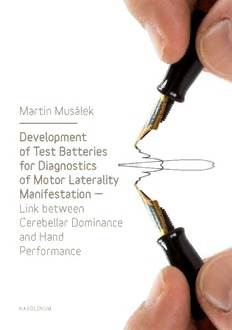
Development of test batteries for diagnostics of motor laterality manifestation : link between cerebellar dominance and hand performance PDF
Preview Development of test batteries for diagnostics of motor laterality manifestation : link between cerebellar dominance and hand performance
In Development of Test Batteries for Motor Diagnostics of Motor oM f Laterality Manifestation – Link Between Cerebellar Dominance Mar t and Hand Performance the author tries to provide a compre- oin t hensive coverage of better understanding of laterality phe- oM r nomenon and its evaluation. All information is presented to Lus aá contribute to the standardization of diagnostic tools assess- tle ek ing the motor manifestations of laterality in children, ado- r a lescents and adults. Moreover, in this monograph he tries to litD| work up and subsequently suggest a new approach to assess y e Mv the motor laterality manifestation by means of relationship e a between cerebellar dominance and hand performance. nlo ifp em Martin Musálek, Ph.D., is an Assistant of Anthropomotorics sten Martin Musálek a at the Department of Kinanthropology, Charles University tt io o in Prague, Faculty of Physical Education and Sport, Czech nf T Republic. e Development s t Mr. Musalek’s monograph represents an impressive amount B of Test Batteries a of work in the development of a diagnostic tool for the as- t t sessment of motor laterality in children and adults, utilizing e for Diagnostics r rigorous psychometric principles and sophisticated statistical ie s methods. f of Motor Laterality o (From the review by Pamela J. Bryden, Ph.D., Professor, r D Manifestation — Wilfrid Laurier University, Ontario, Canada) ia g n Link between o s t ic Cerebellar Dominance s and Hand Performance KAROLINUM development of test batteries_mont.indd 1 2/21/14 11:37 AM Development of TestBatteries for Diagnostics of Motor Laterality Manifestation – Link between Cerebellar Dominance and Hand Performance Mgr. Martin Musálek, Ph.D. Reviewed by: prof. Pamela Bryden, Ph.D. prof. MUDr. Jiří Tichý, DrSc. From Original Czech Version Translated by Radek Blaheta Edited by Alena Jirsová Cover and Layout by Jan Šerých Typeset by DTP Karolinum Press First English Edition © Charles University in Prague, 2014 Text © Martin Musálek, 2014 Translation © Radek Blaheta, 2014 ISBN 978-80-246-2285-9 ISBN 978-80-246-2306-1 (online : pdf) Univerzita Karlova v Praze Nakladatelství Karolinum 2014 http://www.cupress.cuni.cz Dedicated to the memory of Prof. Blahuš who taught me the first psychometric steps. Contents Contents 7 Acknowledgements 11 Aim of this Book 13 1. Phenomenon Called Laterality 15 1.1 Laterality as Concept 15 1.1.1 Asymmetry in Universe 16 1.1.2 Asymmetry and Chirality in Life System 17 1.2 Laterality as Characteristic of Human 18 2. Human Brain 20 2.1 Structural Hemispheric Asymmetry 20 2.1.1 Structural Hemispheric Asymmetry in Relation to Gender 25 2.2 Brain Organization and Motor Control 26 3. Genetic Models of Right- and Left-Sidedness 29 3.1 Different Gene Expression in Right and Left Hemispehere as Basis of Neural Hemispheric Asymmetry 29 3.2 The Annett, Right Shift Theory – A genetic model of handedness 31 3.3 Genetic Model of Handedness Chris McManus, D and C alleles 34 3.4 Other Genetic Models of Handedness 35 4. E nviromental Factors as Possible Cause in Change of Laterality at Human 39 4.1 Birth Stress 39 4.2 Higher Level of Hormone Testosterone in Uterus 40 5. Types of Laterality 43 5.1 Functional Motor Laterality Manifestation 43 5.1.1 Preference 44 5.1.2 Performance Expression of Different Skill of Locomotive Organs in Motor Activity 44 5.1.3 Are Preference and Performance Communicating Vessels or Different Attributes? 45 5.1.4 Dominance 46 5.1.5 Laterality of Locomotive and Sensory Organs 46 5.2 Structural Laterality of Locomotive Organs 51 5.3 S tructural and Motor Manifestations of Laterality in the Ontogenetic Development of the Individual 55 5.3.1 Prenatal Asymmetry 55 5.3.2 Craniofacial Development 56 5.3.3 Motor Manifestations of Laterality in the Prenatal Period 56 5.3.4 Postnatal Development of Motor Manifestations of Laterality 57 5.3.5 Corpus Callosum and Hemispheric Specialization 59 6. Diagnostics of Motor Laterality Manifestation 61 6.1 Diagnostic Tools 62 6.1.1 Preference Tasks 63 6.1.2 Preference Self-reported Questionnaires 70 6.1.2.1 M ethodological and Psychometric Shortcomings of the Most Frequently Cited Diagnostic Tool, the Edinburgh Handedness Inventory 75 6.1.3 Performance Tests 79 6.2 Evaluation of Cerebellar Dominance, New Approach for Approximation of Hemispheric Superiority 82 7. Empirical Research 86 8. Research Questions 89 9. Hypotheses 90 10. Methods 91 10.1 Definition of Theoretical Concept 91 10.2 Determination of Specific Theoretical Concepts 93 10.3 Determination of Structure of Diagnostic Tool 94 10.4 Creating a Complete List of Relevant Items 95 10.5 Content Validity 97 10.6 First Version of Test Batteries 101 10.7 Verification of Intelligibility of Items 103 10.8 The Research Sample and Its Size 104 10.9 F inal versions of Test Batteries Before Collecting the Data 107 10.10 Data Analysis, Evaluation of Structure 114 10.11 Approximation of Reliability 114 11. Structural Equation 117 11.1 Introduction 117 11.2 Types of SEM models 118 11.3 Confirmatory Factor Analysis (CFA) 119 11.4 Categorical Variables and SEM 122 11.5 Types of Parameters Used in SEM Method for Parameters Estimation 125 11.6 Model Testing Fit Evaluation 126 11.7 Residuals 128 12. Results 130 12.1 Test Battery for Adult Population 130 12.1.1 Questionnaire 131 12.1.2 Preference Tasks 140 12.1.3. Performance Tests 152 12.2 Test Battery for Child Population 164 12.2.1 Preference Tasks 164 12.2.2 Performance Tests 176 13. Scoring 186 14. Discussion 190 15. Conclusion 199 16. References 201 17. Appendix 235 List of Tables 238 List of Figures 243 Subject Index 246 A unique painting of a left-handed archer, the only in the world, discovered at castle Houska in the Czech Republic
